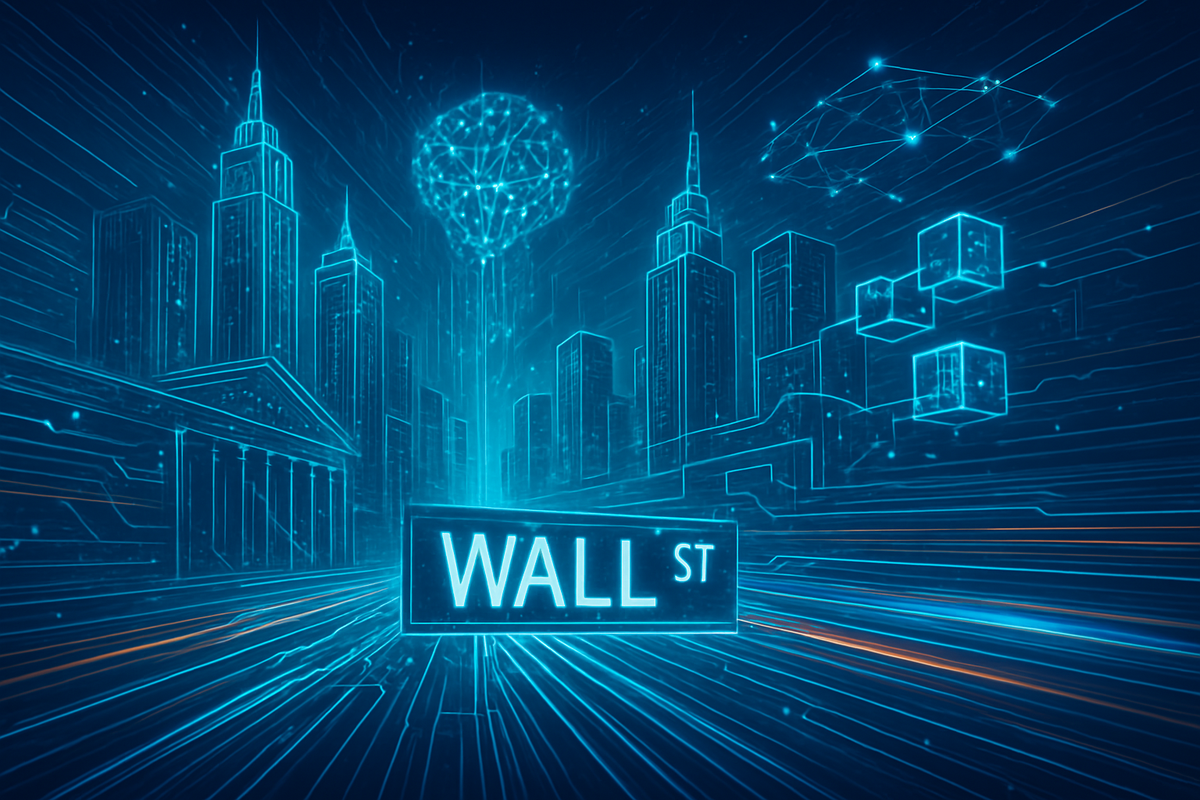
Wall Street is on the cusp of a profound transformation, ushering in an era of unprecedented speed and efficiency in financial markets. A multifaceted technological overhaul, driven by advancements in Artificial Intelligence (AI), blockchain technology, ultra-low latency networking, and cloud computing, is fundamentally reshaping how trades are executed, settled, and managed. This isn't a singular event but rather a systemic evolution, poised to dramatically reduce transaction costs, enhance operational efficiency, and democratize access to financial assets, with significant implications for investors, institutions, and the broader global economy.
As of late 2025, the financial industry is witnessing an accelerated adoption of these cutting-edge technologies. The immediate implications are already tangible, with the U.S. market having successfully transitioned to a T+1 settlement cycle, a move that has already demonstrated significant reductions in corporate bond transaction costs and margin requirements. This technological wave promises not only to optimize existing market structures but also to unlock new avenues for liquidity, transparency, and innovation, setting the stage for a more agile and resilient financial ecosystem.
The Technological Tsunami Reshaping Financial Markets
The current technological update sweeping through Wall Street is a comprehensive overhaul, moving beyond incremental improvements to a fundamental reimagining of financial market infrastructures (FMIs). This transformation is characterized by a push towards greater automation, digitization, and real-time processing across the entire trade lifecycle, from order generation to settlement.
At the forefront are Artificial Intelligence (AI) and Machine Learning (ML). These technologies are increasingly integrated into trading platforms for predictive analytics, sophisticated market forecasting, and real-time sentiment analysis of vast datasets. Generative AI, in particular, is empowering traders with sharper analysis and more responsive decision-making capabilities, enabling automated trading at speeds previously unattainable by human intervention. Firms like Adyen (AMS: ADYEN) launched an AI-powered payment optimization product in January 2025, demonstrating how machine learning can analyze payment data, automate routing, and prevent fraud, potentially boosting transaction success rates.
Another cornerstone of this revolution is Blockchain Technology and Tokenization. This involves converting ownership rights of real-world assets into digital tokens on programmable, distributed ledgers. Smart contracts, self-executing code embedded within blockchain networks, automate tasks like compliance checks, dividend payments, and settlements. This innovation promises near-real-time settlement, significantly reducing the need for intermediaries and slashing operational expenses. Institutions like JPMorgan Chase (NYSE: JPM) and HSBC (NYSE: HSBC) are actively exploring blockchain for various applications, while Goldman Sachs (NYSE: GS) has launched its Digital Asset Platform (GS DAP) for digital bond issuance, which has already shown to save 15 basis points in costs. Citi projects tokenized bank deposits to support $100-140 trillion in annual flows by 2030, with stablecoin adoption surging in 2025.
Low-Latency Networking and Infrastructure remain a relentless arms race, with continuous advancements in high-speed fiber optic networks, improved submarine cable systems, colocation services, and specialized hardware like FPGAs. These technologies are critical for executing trades in microseconds, minimizing the time delay between order initiation and completion, a competitive necessity for high-frequency trading firms. Companies such as QuantVPS, 4OTC, Reactive Markets, and Colt Technology Services are key providers in this arena.
Finally, Cloud Computing is providing the scalable and resilient backbone for much of this innovation. Financial institutions are increasingly migrating their trading and data infrastructure to cloud-native platforms, leveraging public, private, or hybrid cloud environments for their flexibility and robust data management capabilities. Major cloud providers like Amazon Web Services (NASDAQ: AMZN), Google Cloud (NASDAQ: GOOGL), and Microsoft (NASDAQ: MSFT), along with Oracle (NYSE: ORCL), are forming strategic partnerships with financial firms to facilitate this migration, enabling lower latency and higher throughput in trading systems.
Navigating the Shifting Tides: Potential Winners and Losers
The technological paradigm shift on Wall Street will inevitably create a new hierarchy of winners and losers, fundamentally altering competitive landscapes and business models. Companies that embrace and strategically integrate these advancements are poised for significant gains, while those resistant to change may face obsolescence.
Potential Winners:
- High-Frequency Trading (HFT) Firms and Quantitative Hedge Funds: These entities, already reliant on speed and algorithmic precision, will benefit immensely from enhanced low-latency infrastructure and advanced AI capabilities. Their ability to process vast datasets and execute trades in microseconds will be further amplified, potentially increasing their market share and profitability.
- Technology Providers and Cloud Giants: Companies offering AI platforms, blockchain solutions, high-performance computing hardware, and cloud infrastructure stand to gain substantially. Google Cloud (NASDAQ: GOOGL), Amazon Web Services (NASDAQ: AMZN), Microsoft Azure (NASDAQ: MSFT), and Oracle (NYSE: ORCL) will see increased demand for their scalable and secure cloud services. Specialized firms like Palantir Technologies (NYSE: PLTR), which provides data integration and AI platforms, could also see increased adoption within financial institutions.
- Blockchain and Digital Asset Innovators: Firms developing tokenization platforms, digital asset exchanges, and smart contract solutions are at the forefront of this new market. Companies like Coinbase Global (NASDAQ: COIN) and other emerging players in the decentralized finance (DeFi) space, as well as established financial institutions with dedicated digital asset divisions (e.g., Goldman Sachs' Digital Asset Platform), are well-positioned.
- Large, Agile Financial Institutions: Major banks and asset managers that proactively invest in and integrate these technologies into their core operations will gain a significant competitive advantage. JPMorgan Chase (NYSE: JPM) with its Onyx blockchain unit, and Citi (NYSE: C) with its projections for tokenized deposits, exemplify institutions making strategic moves in this direction.
- Market Data and Analytics Providers: As trading becomes more data-intensive, companies providing sophisticated market data, analytics, and AI-driven insights will become indispensable.
Potential Losers:
- Traditional Brokerage Firms with Outdated Infrastructure: Brokerages that rely on legacy systems and manual processes will struggle to compete on speed, cost, and efficiency. They may face dwindling transaction volumes and pressure on their fee structures.
- Intermediaries Whose Roles Are Disrupted by Blockchain: Custodians, clearinghouses, and other intermediaries whose primary function is to ensure trust and record-keeping may see their roles diminished or transformed by blockchain's inherent transparency and automation. While not entirely eliminated, their business models will need significant adaptation.
- Smaller, Under-Capitalized Firms: The high cost of investing in cutting-edge AI, blockchain, and low-latency infrastructure may prove prohibitive for smaller financial firms, making it difficult for them to keep pace with larger, well-funded competitors. This could lead to consolidation in the industry.
- Companies Resistant to Digital Transformation: Any firm that fails to adapt to the new technological landscape risks being left behind, losing market share, and facing declining relevance in an increasingly digitized financial world.
The impact will extend beyond direct competition, influencing mergers and acquisitions, strategic partnerships, and the overall talent landscape as demand for specialized tech skills intensifies.
Broader Significance and Industry Ripple Effects
This technological update is not an isolated event but a critical component of broader industry trends emphasizing efficiency, resilience, and democratization of finance. It significantly accelerates the long-standing shift from manual, human-intensive processes to automated, data-driven operations, impacting every facet of the financial ecosystem.
The move to T+1 settlement, already implemented in the U.S. and planned for Europe and the UK by 2027, is a prime example of how technology is driving systemic change. This reduction in settlement time frees up billions in capital, lowers counterparty risk, and increases market liquidity. It also highlights a global convergence towards more efficient post-trade processing, putting pressure on regions that lag in adopting similar standards.
Regulatory bodies are closely monitoring these developments. The EU’s Digital Operational Resilience Act (DORA), going live in 2025, underscores the importance of operational resilience and cybersecurity in financial markets, a direct response to the increasing reliance on complex digital systems. Regulators worldwide are grappling with how to supervise decentralized finance (DeFi), tokenized assets, and AI-driven trading algorithms, seeking to balance innovation with investor protection and systemic stability. This could lead to new policy frameworks or amendments to existing ones, creating both opportunities and compliance challenges for firms.
Historically, major technological shifts have always reshaped Wall Street. The introduction of electronic trading systems in the 1970s and 80s, the rise of the internet in the 90s, and the proliferation of high-frequency trading in the 2000s all dramatically altered market structures, trading volumes, and competitive dynamics. This current wave, however, is arguably more profound due to the convergence of multiple disruptive technologies. Comparisons can be drawn to the adoption of the telegraph or the telephone, which drastically reduced communication latency and revolutionized information flow, but the current shift involves not just communication but the very nature of assets and transactions themselves.
The ripple effects extend to competitors and partners. Traditional exchanges, for instance, are investing heavily in their own technology stacks and exploring blockchain-based solutions to remain competitive against emerging digital asset platforms. Technology partnerships between financial institutions and fintech companies are becoming increasingly common, blurring the lines between traditional finance and tech. The ultimate outcome is a more interconnected, yet potentially more complex, global financial landscape.
What Comes Next: Navigating the Future of Finance
The immediate future will see a continued acceleration in the adoption and integration of AI, blockchain, and cloud technologies across Wall Street. In the short term, firms will focus on optimizing their existing infrastructure, leveraging AI for more sophisticated risk management, fraud detection, and personalized client services. The race for ultra-low latency will intensify, with continuous investment in network upgrades and specialized hardware. We can expect to see more financial products and services being tokenized, leading to greater liquidity and accessibility for a wider range of investors.
In the long term, the possibilities are even more transformative. Quantum Computing, while still largely in its nascent stages, represents the next frontier. Though widespread practical application is still years away, early use cases are emerging in complex financial risk modeling, optimal portfolio planning, and drug discovery. The combination of quantum with AI (Q-AI) could revolutionize problem-solving in real-time, offering unprecedented computational power. Firms like JPMorgan Chase (NYSE: JPM) are already investing in quantum research, signaling its long-term strategic importance.
Strategic pivots will be essential. Financial institutions will need to invest heavily in upskilling their workforce, fostering a culture of continuous innovation, and attracting top talent in data science, AI, and blockchain. Partnerships with technology firms will become even more critical, as few institutions possess all the necessary expertise in-house. Market opportunities will emerge in new asset classes (e.g., tokenized real estate or art), new trading venues, and specialized fintech solutions catering to the digitized market. Challenges will include managing the complexity of integrating diverse technologies, ensuring robust cybersecurity in an expanded digital attack surface, and navigating an evolving regulatory landscape.
Potential scenarios include the emergence of fully decentralized financial markets operating entirely on blockchain, significantly reducing the role of traditional intermediaries. Alternatively, a hybrid model might prevail, where traditional institutions leverage these technologies to enhance their existing services, maintaining a centralized yet highly efficient financial system. Regardless of the exact path, the financial industry will become more automated, data-driven, and globally interconnected, demanding agility and foresight from all participants.
Comprehensive Wrap-Up: A New Horizon for Wall Street
The technological revolution sweeping Wall Street marks a pivotal moment in financial history, promising an era of unprecedented speed, efficiency, and cost reduction. The convergence of Artificial Intelligence, blockchain technology, advanced low-latency networking, and cloud computing is not merely enhancing existing systems but fundamentally reshaping the architecture of global finance. Key takeaways include the demonstrable benefits of faster settlement cycles (like T+1), the transformative potential of tokenization to reduce costs and increase liquidity, and the critical role of AI in automating and optimizing every stage of the trading lifecycle.
Moving forward, the market will be characterized by intense competition, driven by technological prowess. Firms that prioritize digital transformation, invest in cutting-edge infrastructure, and embrace innovation will thrive. Investors should watch for continued advancements in AI-driven trading platforms, the expansion of tokenized assets beyond traditional securities, and the ongoing development of regulatory frameworks that seek to balance innovation with stability and consumer protection. The long-term implications of quantum computing, though still distant, also warrant monitoring as a potential future disruptor.
This digital overhaul signifies more than just an operational upgrade; it represents a fundamental shift in how value is created, exchanged, and managed within the financial system. The lasting impact will be a more accessible, transparent, and resilient market, albeit one that demands continuous adaptation and strategic foresight from all participants. The journey towards a fully digitized Wall Street is well underway, promising a dynamic and potentially lucrative landscape for those prepared to navigate its complexities.
This content is intended for informational purposes only and is not financial advice






